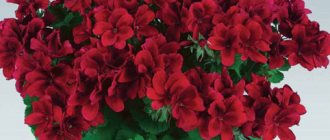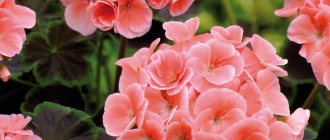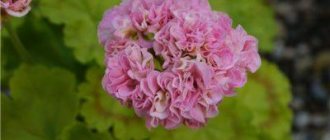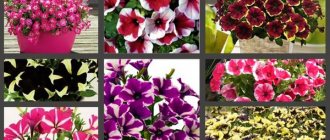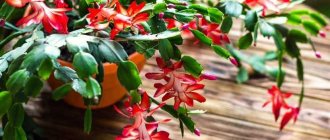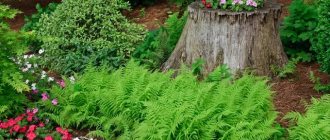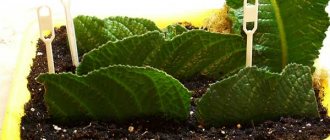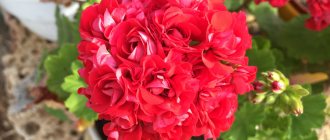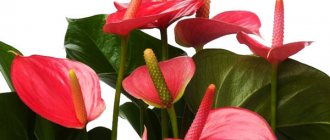Botanical description and history
Norland is a double, zonal geranium, the distinctive feature of which is considered to be increased decorativeness. This is a hybrid that can be grown both on a windowsill and in open ground. Some seed producers attribute this variety to rosebuds, but this is not so - it is a zonal pelargonium species.
Northland is a fairly unpretentious species; it requires standard care and watering. The only difficulty that a novice gardener may encounter is the formation of a bush.
Where and how to plant it?
If you decide to plant this flower with seeds, then no one will give you clear recommendations on sowing. Experts advise sowing seeds in spring or summer, when there is a lot of heat and sunlight.
Experienced flower growers consider the best time for planting to be early March. Then the first buds can be seen already in July. Others say that sowing should be done in late November or early December, arguing that when germinating seeds, sunlight is not necessary, and when seedlings appear, lighting can be installed. Therefore, they are engaged in seedlings almost all year round. It is worth noting that geranium will grow to medium size in about 4-5 months.
Lighting and location
Like all pelargoniums, Norland needs to be sanctified; there should be a lot of light, but direct sunlight can leave burns on the leaves and flowers. Therefore, at noon you need to arrange shading; the rest of the time the light should be good and diffused.
Both direct sunlight and lack of light have the same effect on pelargonium - it refuses to bloom. At the same time, lush greenery is formed.
Norland is a variety that does not tolerate stuffiness; the optimal temperature for good growth and rapid flowering is + 18-23 degrees in summer, while +12 is enough in winter. Open air has a beneficial effect on geraniums, which is why they are placed on a terrace, balcony or in the garden for the summer.
Soil requirements
The soil for zonal pelargoniums needs to be very nutritious, fertile, and rich in microelements. You can buy it in a store or make it yourself. The composition of the soil is as follows:
- 2 parts peat;
- 2 parts leaf soil;
- 1 part coarse sand.
Drainage is very important to the plant. Pelargonium does not like stagnation of water in the pot, as the roots rot and the plant dies. Expanded clay, fine pebbles, crushed brick, fine gravel, and so on are used as drainage. The roots of the plant need oxygen, so the earthen ball must be constantly loosened.
Advice. You should not add a lot of peat to the soil, it retains moisture - the soil will be constantly waterlogged.
Zonal pelargonium
Semi-double flowers, pink. The bush is erect, dwarf, well formed, good bushiness. Finger-shaped leaves.
Terry, pink with coral tints, large inflorescences. Erect, dwarf, well formed, good bushiness.
Terry, white-pink, large inflorescences. Erect, dwarf, well formed, good bushiness.
Terry, pink with a crimson center, large inflorescences. Erect, dwarf, well formed, good bushiness.
Terry, coral color. Cap, large flowering. Erect, medium size, medium formation, good bushiness.
Semi-double, white-pink color with a crimson eye. Abundant flowering, large flowers. Upright, compact. Well formed, good bushiness.
Semi-double, coral red. Upright, compact. Well formed, good bushiness. Unpretentious.
How to properly care?
Pelargonium Norland - grows and blooms well in a pot on the windowsill, but in order for the flowering to be abundant, you will have to take care of it. The rules are not complicated, but in order for the plant to be strong and healthy, it is advisable to follow them unquestioningly.
Watering
In summer, watering should be plentiful and very frequent, since during hot periods pelargonium flower buds may fall off due to lack of moisture. But at the same time, you should not over-water the plant, and if moisture has accumulated in the pan after watering, it must be drained - this will prevent rotting of the roots.
When watering, use only settled, soft water that does not contain limescale. There is no need to spray pelargonium during flowering; it can not only lose its decorative effect, but also rot.
Top dressing
For Norland pelargonium, only mineral fertilizers are applicable. Feeding the plant is strictly prohibited. But this applies not only to this variety; all geraniums have a negative attitude towards organic fertilizers. It is better to apply mineral complexes during the period of active growing season and rapid flowering. Feeding is done once every 2 weeks in summer. As for the winter period, there is no need to add additional food.
Transfer
Pelargonium does not like frequent transplants , so it is obviously better not to touch it until the pot becomes cramped. This is very easy to determine - the roots of the plant will stick out from the drainage holes.- When replanting, you should not take a large pot - pelargonium will stop blooming; each new pot should be 1.5 cm larger than the previous one. Flowering begins only after the earthen ball is completely filled with roots.
- The soil in the pot must be completely replaced . To do this, carefully free the roots from the old soil, trying not to damage them, then transfer the pelargonium to the new soil. After replanting, fertilizing is not carried out for a month and a half, since the new soil is already nutritious.
- You cannot touch the plant during the active growing season ; you need to wait until the pelargonium fades and goes into a dormant state. It will also tolerate transplantation well in early spring.
Attention! Many gardeners claim that after pelargonium grows to 30 cm in height, it is no longer necessary to replant it.
Trimming
Pelargonium Norland needs high-quality and regular pruning. This is the only way to form a beautiful, compact and dense bush with large double flowers.
This process is carried out in the spring, the shoots are shortened by a third. Pruning allows you to stimulate the flower to form new shoots and bloom luxuriantly. If you do not pinch and trim, the geranium will stretch tall, the lower leaves will fall off the stems and you may not even get flowers. In the fall, dry and weak shoots are removed from the bush so that during the dormant period the pelargonium gains strength for new flowering.
Video tutorial on pruning pelargonium:
Types of pelargonium
In total, there are over 250 varieties of the Pelargonium family alone. The entire geranium genus has many more variants. But only certain species have become widely known. Based on general features, they can be divided into 6 categories.
Fragrant pelargoniums
As the name suggests, these varieties are famous for their distinct aroma. Keep this in mind when choosing home flowers, because their smell sometimes causes a headache.
These pelargoniums are often quite inconspicuous. These are loose branched bushes with variegated palmate or lobed leaves. The flowers are miniature, not so frequent, pale or pink.
Such geraniums can smell like herbs, fruits and berries, and even more complex compositions. They are especially appreciated by perfumers.
Ivy-leaved pelargoniums
The variety got its name due to its resemblance to ivy, which spreads and wraps around the base; elongated shoots grow up to a meter. This is an interesting decorative covering solution. Dense leaves with a smooth and bright surface are also reminiscent of ivy.
Sizes and colors differ among different varieties. This geranium is used to decorate balconies and arches.
Zonal pelargoniums
The most popular type of geranium includes tens of thousands of varieties. Flowers - double, non-double or semi-double, with 5-8 petals. Zonal pelargonium is a bushy plant with fragrant leaves drooping down.
It is because of the leaves that the species got its name. There is always a separate zone of a different color in the center. It disappears in the cold season, but appears again with the spring sun's rays.
Royal pelargoniums
These are large varieties bred specifically for decorating palaces. Powerful bushes grow up to half a meter and attract attention with large and graceful fringed or corrugated flowers.
Due to the veins and spots, the petals are not uniform. This makes them look even more interesting. But the flowering of such pelargonium lasts only a season, when an ordinary one can bloom all year round. Another interesting feature is the wide, serrated leaves. They look like maple trees.
Uniques
This is a rare and ancient species, which was specially cultivated by crossing different varieties of brilliant and royal pelargonium.
Common diseases and pests
There is no house plant that is not subject to disease and pest attacks, and Norland pelargonium is no exception. What infections and insects can harm the plant:
Gray mold is the most common disease of fungal origin, which spreads very quickly.
The first sign of gray rot is spots that can appear on any part of the flower; the leaves are the first to be affected, then the stems and inflorescences. A parasitic fungus develops if there is a lot of nitrogen and moisture in the soil. Fungicides will help cope with the disease: Vitaros, Rovral, Fundazol.- Root and stem rot - by the name you can understand which parts of the plant they affect. The reason is also waterlogging.
- Whitefly, mealybug - a plant affected by these insects stops growing, loses its decorative appearance, withers, and if not controlled, may die. To combat, you need to use special chemicals - insecticides.
Reference. Pelargonium is rarely attacked by insects due to its specific smell.
Privacy Policy
General provisions
Some objects posted on the site are the intellectual property of StoreLand. The use of such objects is established by the current legislation of the Russian Federation.
The StoreLand website contains links that allow you to go to other sites. StoreLand is not responsible for the information published on these sites and provides links to them only to provide convenience to visitors to its site.
Personal information and security
StoreLand guarantees that any information received from you will never, under any circumstances, be provided to third parties, except in cases provided for by the current legislation of the Russian Federation.
In certain circumstances, StoreLand may ask you to register and provide personal information. The information provided is used solely for official purposes, as well as to provide access to special information.
Personal information can be changed, updated or deleted at any time under Account > Profile.
Features of reproduction
The most common method of propagating pelargonium is cuttings, and we will consider it. If you decide to cut a cutting from the mother plant, then it is better not to let it bloom for a year, this is the only way the planting material will be strong and healthy. If everything is done correctly, then this same summer the young plants will delight you with their flowering.
The algorithm of actions is as follows:
- Shoots for propagation are cut in March, using a sharp, sterile instrument. The cut is made at an angle of 45 degrees. You need to leave 2-3 internodes on the cuttings.
- The cuttings are dried in air for 10 hours.
- Remove leaves from the bottom of the prepared cuttings, otherwise they may rot in the ground.
- The cuttings are immediately placed in soil, which consists of sand, soil, perlite and vermiculite. Before planting, the substrate is moistened.
- Cover the cuttings with a glass jar, and do not forget to ventilate every day.
- The roots of the shoot will appear in about a week and a half. Immediately after this, the jar is removed, and the young plant is fed with a mineral complex.
Pelargonium is a beautiful and fragrant plant that is suitable for indoor and outdoor cultivation. You can view our materials about other varieties Bold, Clara Sun, Grandiflora, Richard Hudson, Zonartik, Prince Gustav, Mildfield Rose, Patricia Andrea, Salmon, Lady Gertrude on our website.
Pelargonium Norland is a flower that is loved in many countries. The decorative qualities of the plant and ease of care make it possible to grow this beautiful flower everywhere.
Usage
The main purpose of pelargonium is to decorate buildings and courtyards. You can plant them in the foreground in flower beds or create compositions with other potted flowers.
In addition, the smell of pelargonium refreshes the room. Phytoncides found in leaves and other parts of the plant kill pathogens. Therefore, they are placed in jars of jam to prevent mold from growing.
Oil from pelargonium leaves is used to treat dermatitis and other skin diseases. It helps with burns. Preparations from pelargonium leaves are used to increase blood clotting. The decoction is used to gargle for pharyngitis.
More information can be found in the video:

